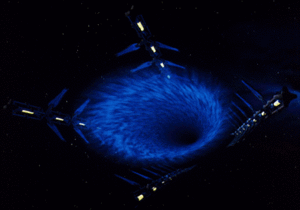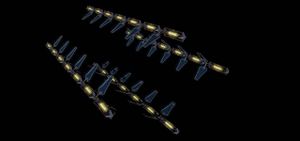


A jump gate is an opening that allows a vessel to move into Hyperspace. The gate itself is constructed of 4 very large pylon structures which are arranged in either orbital or extra-orbital space. Each structure is kept in a specific configuration of varying sizes from the others. Each structure operates by projecting an incredibly strong, stable, subspace force on a specific plane relative to the other structures. These planes align and intersect in a cone shape with a focal point of the 4 planes at one end of area between the gates opening outward toward the other end in a funnel.
The opposing subspace fields cross each other at right angles and pull the barriers between subspace and normal space apart, bending space-time like a quantum singularity would in nature. This stable subspace vortex is targeted into a specific subspace domain known as Hyperspace. This vortex is known as a Jump Point.
Power
Each structure is powered by a series of fusion reactors and a pair of matter-antimatter cores which provide high energy warp-plasma to an immense array of field coils along its length. The field coils take approximately 5 days to charge after being powered down in order to safely create a jump point. To power down a jump gate safely takes 2 days for the field coils to safely vent warp plasma into space and be fully powered down.
As such a jump gate is kept powered at a stable capacity to be used when needed.
Beacons
Each jump gate acts as a subspace antennae broadcasting into Hyperspace as a navigational beacon to allow for safe navigation through hyperspace.
Safety
Since a jump gate uses an incredible amount of power they are extremely dangerous when disrupted. A jump gate that is forced closed (through disruption of the vortex while in operation) can cause an explosion greater than that of an exploding planet, since most jump gates are operated by governments or occasionally by large corporations, they are kept as highly secured facilities usually operated by the military in the case of a government or a dedicated operations team in the case for corporations. Private jump gates are regulated through interstellar law in accordance with standards set forth by various treaties and legal documents.
Warp Drive / Jump Gates
Warp technology (and as a result Dimensional Folding) is completely incompatible with that of a jump gate. A warp-capable vessel entering a jump point must completely discharge its warp field coils of all warp power and shut down its matter/antimatter reactor before crossing the event horizon into the vortex. To do otherwise would result in the warp coils collapsing and the resulting shock wave to entirely destroy the ship breeching the warp core. An operating warp core entering a jump point would also risk force-closing the gate itself and destroyed everything within range of the resulting explosion.
A matter/antimatter reactor can operate within hyperspace without issue. However, the high energy plasma produced for warp travel causes hyperspace to fold back in onto itself and thus powering up a vessels warp drive within hyperspace would cause the ship to be completely destroyed in a massive core breech after the warp coils themselves are collapsed in upon themselves. Due to this danger it is illegal for a matter/antimatter reactor to be in operation while in hyperspace or before entering a jump point.
Gravitational Displacement / Jump Gates
A GCD has no possible way to operate in hyperspace and would need to be shut down before entering a jump point. Though many vessels small enough to have a GCD use hyperspace for travel. An Oscillating Mercury Core does not need to be shut down prior to entering a jump point, but a modified Warp Drive system that also acts as a GCD would still require to be completely shut down.